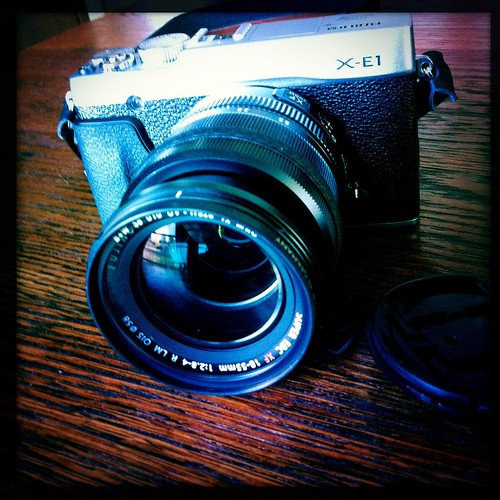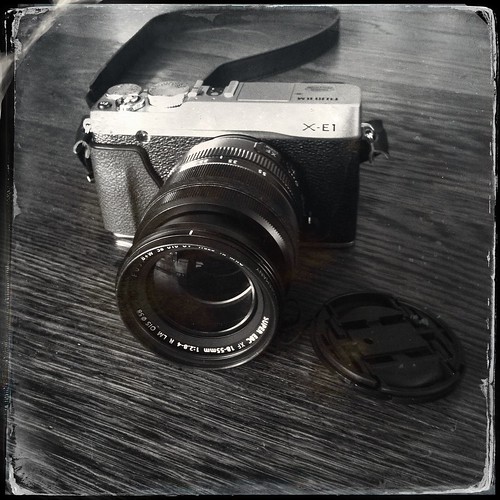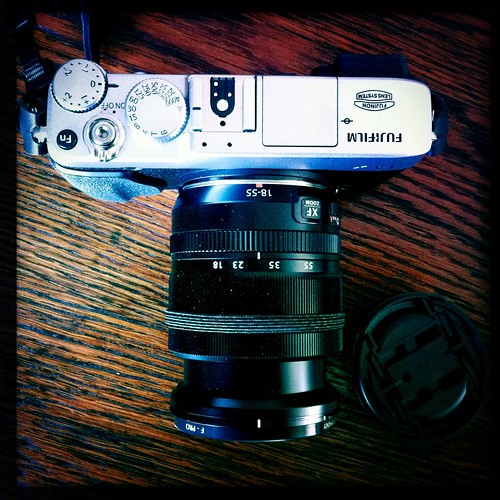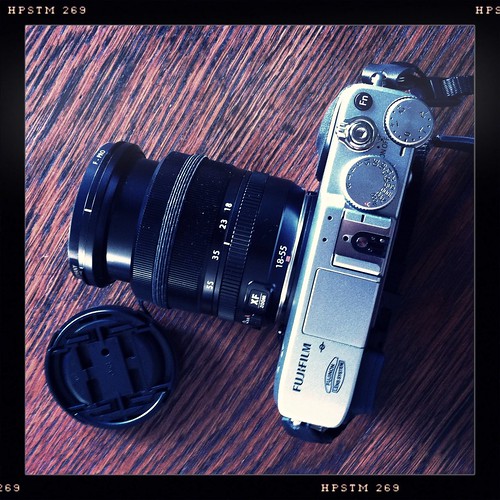Yesterday I bought a new camera, a Fujifilm X-E1. I've been coveting it since it was announced: it looks like the rangefinder cameras my dad had when we lived in Brazil in the late 1960s and early 1970s, the specs are fabulous, and the reviews have been pretty ecstatic. My wife and I went to the camera store, checked out a couple different models, and after some deliberation, we took the plunge.

via flickr
We thought about a Nikon D7000, because we already have a D5000 and are quite happy with it. But while the D7000 gets great reviews, I felt that the X-E1 would be better for the kinds of professional uses I expect to put a camera to in the coming years– lots of street photography and observations of people using devices– and it'll be very easy to travel with. The D7000 is fabulous, and feels equally professional, but it's a much heavier camera, both physically and visually. This one will be less obtrusive.
Though I've had it for about 18 hours (8 of which I've been asleep), and have mainly taken pictures of the dog (who I don't photograph enough) and my son and his friend (who are having a sleepover), I think it's going to be a camera I can spend years working with.

via flickr
As you can see, it's got a very retro, Leica rangefinder aesthetic, though it has an electronic viewfinder rather than an optical one (or the cool hybrid that the X-Pro1 has). Of course, you can set everything to adjust itself automatically; but exposure speed, aperture, and focus all have dedicated manual controls on the camera or lens, and the ISO can be accessed from the Fn button just beside the shutter button.
Dive into the options menus, and there are tons of other things you can adjust, custom profiles you can create (that'll be next on my to-do list), and special effects– simulators that mimic the distinctive color profiles of different Fuji films, a couple black-and-white films, and so on.

via flickr
The other two things about it that I think I'm going to love are that it's very light, and it's surprisingly small.
The pictures don't really give you a good sense of how small the camera is. The body is about a quarter inch longer than an iPhone, and perhaps a quarter inch taller, so it's Not Large At All. And the body weighs about 12 ounces (350 g), which is Really Light.
So while it's mean to be a two-handed camera, you can comfortably carry it in one hand.

via flickr
My talks feature all my own pictures, and so having good a good camera is a professional necessity; it's an important part of the Brand of Me, and helps me get my ideas across to my audiences.
More than that, though, I feel like this is the kind of device I could spend a decade working with. These days, as specs constantly improve and costs drop, it's easy to convince yourself that the Next Cool Thing will make you a better photographer, or writer, or golfer, or guitarist. Of course, there is a marginal truth to that, but it's a lot more important to learn how to use a device to improve your own ability to see, or your voice.
That doesn't mean NOT taking advantage of technology. It not relying on its improvement alone, and being thoughtful about how you can both exploit it and improve yourself. (There are things I've almost completely outsourced to devices. In the last ten years I've memorized the phone numbers of my wife and kids, but entrust all the others to my iPhone.)
There's one other calculation for me. As I get older and more reflective, I think less about how many more turns of Moore's Law I can consume, and how many cool devices I can acquire. The challenge isn't to get the Next Great Thing, but the Last Great Thing: as much as possible, to choose things that, whether I live another five years or another fifty, will last; serve me well; constantly give me pleasure; and help me consciously extend or augment my own abilities. This requires a level of thoughtfulness and self-understanding, and frankly a certain amount of money: a $1400 camera is a lot more likely to fall into this category than a $300 one.
So we'll see if I made the right choice.